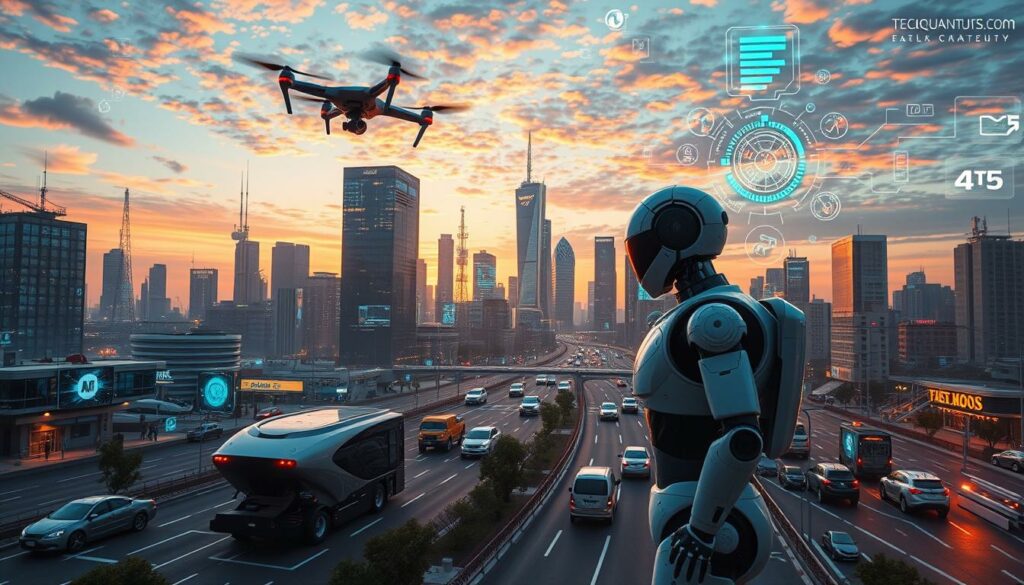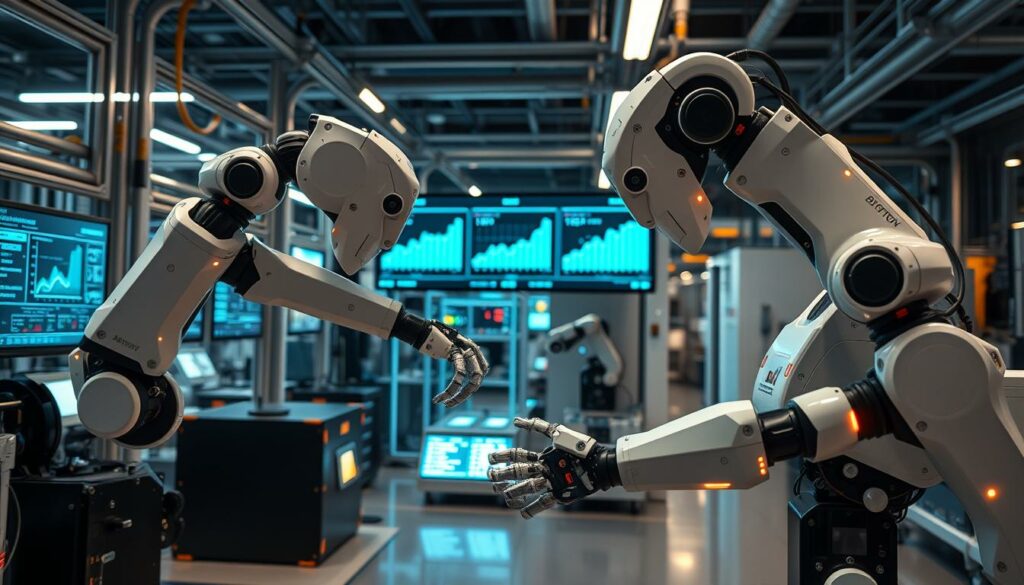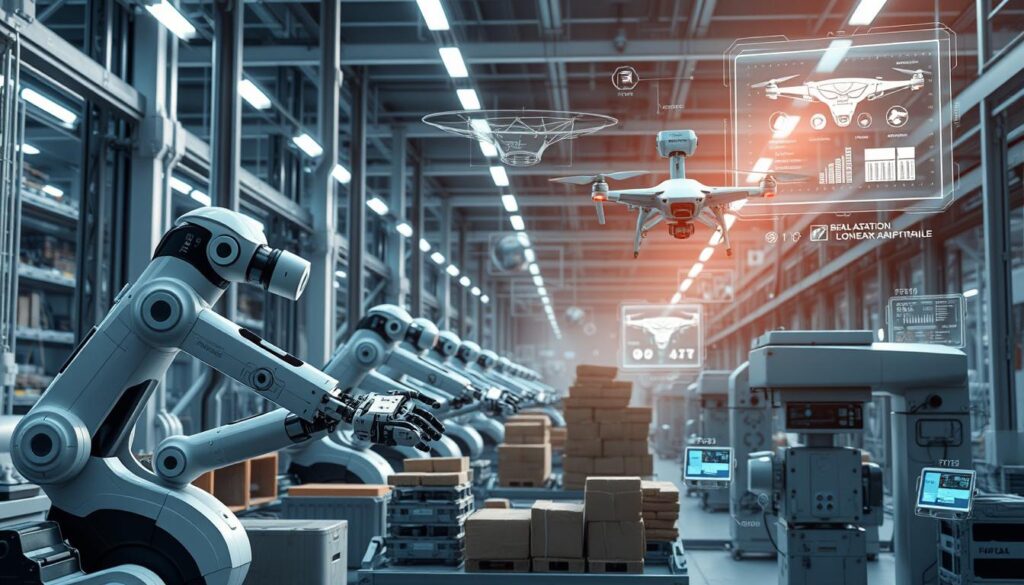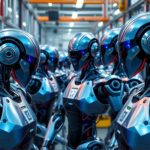Did you know that robots with AI can make warehouse work up to 90% better? They help with tracking inventory and filling orders. AI and Robotics are changing how we automate, making things more efficient and productive. Companies are seeing how AI helps robots move around, make quick decisions, and keep things safe.
This article will show you how AI and Robotics work together in automation. You’ll see how Machine Learning makes robots better, and the benefits they bring to work. From using AI for maintenance to robots that can handle objects with precision, it’s all about the future of work.
For more on using robotics, check out implementing robotics for business process automation.
Key Takeaways
- The integration of AI technologies in robotics leads to enhanced efficiency in automation.
- Autonomous robots can significantly optimize warehouse operations with high precision.
- Machine Learning plays a critical role in advancing robotics capabilities.
- Advanced safety features, such as collision avoidance, are becoming standard in future machines.
- The use of predictive maintenance can avert costly equipment breakdowns.
- Robotics technologies are key in improving business productivity and operations.
Introduction to AI and Robotics in Automation
The mix of artificial intelligence and robotics is changing how we automate things. Businesses want to work better and faster. The introduction to AI systems help make robotics in automation better. This helps companies work more efficiently and save money.
For example, restaurants like Chipotle see more orders for salads or bowls. This shows how automation meets customer needs well.
AI has changed how we work. Places like McDonald’s use touchscreens for orders. By 2020, these devices were everywhere. This makes things easier and lets workers focus on more important tasks.
Fast food jobs have grown by 150,000 in the U.S. This is a 3% increase from before the pandemic. It shows that automation can make jobs better, not just replace them.
Ben Zipperer says automation makes workers more effective. This leads to better business results and keeps food prices low for people. Companies aim to use technology wisely, keeping their employees valuable. As technology gets better, it will change how businesses work and what work means.
The Role of AI in Robotics
AI in robotics is a big step forward in tech. It shows how AI algorithms help robots do simple and complex tasks. AI algorithms make robots better at their jobs, adapting to new situations and tasks.
Reinforcement learning is a key example. It lets robots learn from past experiences to make smarter choices.
Understanding AI Algorithms
AI algorithms are key to how robots work. They help robots make decisions by processing information. Machine learning in robotics lets robots get better with time.
Robots with advanced AI can do tasks on their own. This makes them more productive and efficient.
Machine Learning and Robotics Synergy
Machine learning and robotics work together to make robots better. This partnership helps robots adapt to different situations. It shows how AI can change robotics for the better.
Robots can help the elderly with daily tasks. They collect data in real-time to assist. This improves the lives of those who use them.
Learning about this connection can give us a peek into the future of AI and robotics. For more on how these technologies help in caregiving, check out this article.
https://www.youtube.com/watch?v=W5C4_pjeOmQ
How Robotics Enhance Automation
Robotics is changing industries with new solutions for automation. Knowing the different types of robotics helps businesses use these technologies well. Each type, from autonomous mobile robots to industrial manipulators, has its own role. They make operations more efficient and productive.
Types of Robotics Used in Automation
Today, there are many types of robotics for different needs. Each type has special features to improve automation. Here are some main categories:
- Industrial Robots: These fixed machines are great for tasks like welding, painting, and packaging on assembly lines.
- Collaborative Robots (Cobots): Cobots work with humans without safety cages. They make operations more flexible.
- Service Robots: Used in hospitality and healthcare, these robots help with cleaning, delivery, or patient care.
- Autonomous Mobile Robots: These robots move on their own. They’re used in warehouses and logistics for efficient goods movement.
Benefits of Robotics in Business Operations
Robotics brings many robotics benefits to business operations. Here are some key advantages:
- Increased Efficiency: Robots do tasks faster and more accurately than humans. This reduces downtime and boosts output.
- Cost Savings: Automating tasks saves on labor costs and reduces errors. This leads to big financial gains.
- Improved Safety: Robots handle dangerous tasks, keeping workers safe and reducing injury risks.
- Scalability: Robotics can grow with your business easily. This avoids the hassle of hiring and training new staff.
Adding robotics to your operations is key to modernizing your business. By knowing the types of robotics and their benefits, you can boost efficiency and welcome the future of automation.
IT Robotics: Bridging the Gap Between Technologies
IT and robotics together have changed how companies work. They make communication smooth and improve how we understand operations. This mix helps businesses work better and faster.
The Relationship Between IT and Robotics
IT and robotics need each other for data and control. IT robotics connects them, making sure info moves well between software and hardware. This teamwork gives businesses big benefits, like:
- Improved data analysis for smarter choices.
- Enhanced automation of simple tasks for better efficiency.
- Cost savings from less manual work and fewer mistakes.
Real-World Applications of IT Robotics
In many fields, IT robotics makes a big difference. For example, in logistics, it helps manage stock and speed up orders. IT and robotics together make warehouses run better by using data for upkeep and tracking.
In human resources, IT robotics changes how we hire. It can check resumes and set up interviews, saving time. This lets HR people focus on big-picture tasks.
| Industry | Application | Benefits |
|---|---|---|
| Logistics | Automated inventory management | Optimized order fulfillment and tracking |
| Healthcare | Robotic surgeries | Increased precision and reduced recovery times |
| Manufacturing | Quality assurance automation | Lower defect rates and improved product quality |
| Education | Adaptive learning systems | Personalized education experiences for students |
IT and robotics together have huge potential in many areas. They make things more efficient and innovative. As they keep getting better, they’ll play an even bigger role in the future.
Challenges in Implementing AI and Robotics
Adding AI and robotics to work life is tough. One big problem is getting workers to use new tech. Training and support help workers feel comfortable with change. But, without the right skills, moving to new tech can be hard.
Workforce Adaptation to New Technologies
Bringing AI and robotics into the workplace is a big challenge. Workers might struggle to adjust to new roles and tech. To help, companies should invest in training. This way, workers can learn and use AI and robotics with ease.
Technical Limitations of Current AI and Robotics
AI and robotics have many benefits, but they’re not perfect. They face issues like processing power, bias, and needing specific data. Fixing these problems is key to making AI work better in the office. Companies need to tackle these issues to make AI a success.
| Challenge | Impact | Possible Solutions |
|---|---|---|
| Workforce Adaptation | Resistance to change, skill gaps | Invest in training programs and workshops |
| AI Limitations | Processing issues, biased data | Regular updates, algorithm audits |
| Technical Dependency | Reliance on structured data | Diverse data training sets, regular assessments |
Knowing these challenges helps companies plan better. This way, they can use AI and robotics without too much trouble. For more on these topics, check out this resource.
The Future of AI and Robotics in Automation
The future of AI looks bright for changing many industries with robotics and new automation trends. Industries are getting more complex, and new tech aims to make things more efficient. A big trend is making robots smaller but more powerful, so they can work in many places.
AI is making tools easier to use, making life better for both humans and machines. This leads to new ideas that were once impossible. The arrival of fully autonomous systems could change how industries work. This raises big questions about jobs and what skills people will need in the future.
Automation has changed the logistics industry a lot. Now, machines do tasks that were once done by people. This lets workers focus on supervising and managing equipment. It’s a big change, moving jobs from simple to more skilled ones.
To show how big these changes are, here are some numbers:
| Statistic | Details |
|---|---|
| U.S. Unemployment Rate | 4.3% as of July 2024, one of the lowest in decades despite increasing technology adoption. |
| HR Professionals Prioritizing AI | Nearly half reported AI in HR support becoming a priority in the 12 months following January 2023. |
| Job Growth Importance | 79% of frontline workers cited job growth as crucial for career advancement, according to a McKinsey study. |
| AI in Recruiting | AI tools identify skills gaps in candidates, aiding in better hiring and upskilling opportunities. |

These numbers show the good and bad sides of AI and robotics. As these trends grow, they will change many jobs. It’s important for workers to be able to adapt to new technology.
The Impact of Automation on Employment
Automation changes the job world, leading to important talks about the future of work. AI is now in many fields, changing how we work. While some jobs might go away, new ones with unique skills are coming.
Changing Nature of Work in the AI Era
The job world is changing with automation. Jobs we knew before might not exist anymore. But, new jobs that need special skills are popping up.
For example, McDonald’s started using touchscreens for orders. This move led to 150,000 new jobs in fast food. It shows that jobs are changing, not disappearing.
AI is making us learn new things in healthcare and retail. California is making laws to help us deal with these changes. They want to make sure we know how AI works.
Safety Improvements Through Automation
Automation is making workplaces safer. It helps in areas where accidents are common. For example, robots in logistics can lift heavy things and do repetitive tasks, reducing mistakes.
These safety improvements protect workers and make work more efficient. Laws like SB 1120 help make sure AI is used right. They make sure it helps everyone, not just a few.
As technology and people work together, it’s key to understand the job changes. Staying updated on AI can help you see how work is changing. It might make your job safer and more efficient.
To learn more about how automation is changing jobs, read this important article on robotics trends.
Case Studies of AI and Robotics Collaboration
Looking at case studies in robotics shows how different industries have used AI and robotics together. These examples show how these technologies have changed business for the better. They give us insights that can help us use AI and robotics in new ways.
Successful Implementations in Various Industries
Many fields have seen big benefits from AI and robotics. For example, a big car parts supplier saved a lot of money by working with their IT team. They found the best way to get rid of old servers, saving over $500,000 in just six months.
Transurban, a toll road company in Australia, also made a big change. They used ServiceNow IT Operations Management with AWS Cloud. This created a reliable system that kept data accurate, showing how important good data management is.
Lessons Learned from Real-World Examples
Case studies in robotics teach us about success and challenges. One important lesson is to make sure technology fits with the company’s goals. For instance, using ServiceNow’s ITOM helped a company quickly adapt and see what they had, showing the value of being flexible.
Also, the story of using automation tools like Cloud Discovery and Event-driven Discovery teaches us to keep up with new tech. By staying ahead, companies can stay competitive and keep growing.

Ethical Considerations and Regulations
The world of ethics in AI is changing fast. This is because of more rules from governments and public pressure. As AI and robotics get better, companies must think about how they affect society. In California, there are many laws to make sure AI is used right, like protecting data and avoiding bias.
California’s Governor, Gavin Newsom, has signed 18 important bills about regulations in robotics and AI. These laws cover many parts of using AI ethically. Some key rules include:
| Bill Number | Description | Effective Date |
|---|---|---|
| AB 2013 | Generative AI providers must disclose data used for training systems. | 2026 |
| AB 2885 | Establishes a uniform definition of artificial intelligence. | N/A |
| AB 3030 | Healthcare providers must disclose the use of generative AI for patient communication. | N/A |
| AB 2905 | Robocalls with AI-generated voices must be disclosed. | N/A |
| SB 926 | Criminalizes blackmail using AI-generated nude images. | N/A |
| SB 981 | Social media platforms to establish reporting channels for deepfake nudes. | N/A |
The robotic warfare market is expected to grow to over US$33.6 billion in 2024. This means we need rules to keep things safe. New tech brings chances but also raises big questions about ethics in defense. Lawmakers are trying to find a way to balance new tech with safety.
These laws show California’s effort to set good standards for AI and robotics. There are still challenges, but the state’s actions are helping to lead the way in using AI responsibly.
Technological Innovations Driving AI and Robotics
Technology advancements are key to AI and robotics growth. New trends shape the future of automated systems. They make these systems more efficient and intelligent.
As industries adopt these innovations, they change how tasks are done. They also improve how services are delivered.
Emerging Trends in Automation Technologies
Today, we see many exciting tech advancements in AI and robotics:
- Edge Computing: It processes data near the source, making robots work faster and more smoothly.
- Enhanced Sensor Technologies: Better sensors help robots understand their surroundings better. This leads to more accurate and quick actions.
- Advanced Human-Robot Interaction: New ways for humans and robots to talk improve teamwork. This boosts productivity and safety in many areas.
- Robotaxi Services: Companies like Tesla plan to start robotaxi services by 2025. This marks a big step towards self-driving cars.
- Vehicle-to-Grid Technologies: Companies like Nuvve Holding Corp. are looking into new ways to manage energy. They’re bringing robotics into the energy world.
These innovations could lead to smarter systems and new ways of interacting. With the right use of these technologies, robotics will keep evolving. It will show us what’s possible with automation.
Conclusion
In our look at AI and robotics, we’ve seen how they change the future of work. They work together to make things more efficient and safe in many fields. This shows how companies can use these tools to improve how they work and create new jobs.
Looking at the challenges, it’s clear that keeping up with AI and robotics is key. The future of work will see big changes thanks to these technologies. Being ready for these changes is important as they grow and change.
This summary on AI and robotics reminds us of their big impact on work. Learning about these technologies helps us see the good and the tough parts. Let’s use AI and robotics to make our work world better and more efficient.
FAQ
What are AI and robotics, and how do they work together in automation?
AI stands for artificial intelligence. It makes machines smart like humans. Robotics is about using robots to do tasks automatically. Together, they make robots smarter and more efficient in many fields.
What types of AI algorithms are used in robotics?
Robotics uses AI algorithms like reinforcement learning and neural networks. These help robots learn and get better over time. They make decisions based on what they see and feel.
How do robotics enhance automation in business operations?
Robotics makes businesses run faster and more efficiently. It cuts down costs and makes workplaces safer. This helps companies make more money and stay competitive.
What challenges do organizations face when integrating AI and robotics?
Companies struggle with getting workers used to new tech and dealing with AI’s limits. They face issues like employee resistance, skill gaps, and bias in AI. These problems can slow down progress.
How can automation impact employment dynamics?
Automation changes jobs, sometimes making some obsolete. But, it also creates new, better jobs. It makes workplaces safer, especially in dangerous places like warehouses.
What are some examples of successful AI and robotics collaboration?
Many industries have seen big wins with AI and robotics. For example, in manufacturing, logistics, and healthcare. These successes show how these technologies can solve big problems and make things better.
What ethical considerations surround AI and robotics?
There are big ethical questions about AI and robotics. Like privacy, bias, and how to use them right. Companies must follow rules and keep trust with the public.
What are the future trends in AI and robotics?
The future looks exciting with smaller robots, AI in everyday things, and fully self-driving systems. These changes will change jobs and make things more efficient.
How do technological innovations propel AI and robotics?
New tech like edge computing and better sensors are pushing AI and robotics forward. They help make systems smarter and more independent. This will change how we automate things in the future.
Source Links
- Automation, robotics and AI will guide the future of manufacturing
- How to upgrade your ‘incompatible’ Windows 10 PC to Windows 11: Two options
- Data, pilot projects showing food service robots may not threaten jobs • Ohio Capital Journal
- My Guide to Understanding Data Centre Architecture: Core Components Every IT Pro Should Know
- Wazuh Home Network Setup: A Step-by-Step Guide
- Quantum Computers Decrypting Blockchain: The Risks and Implications
- Wazuh: Enterprise-Grade Security for Your Business
- Wazuh for Beginners: A Comprehensive Guide




